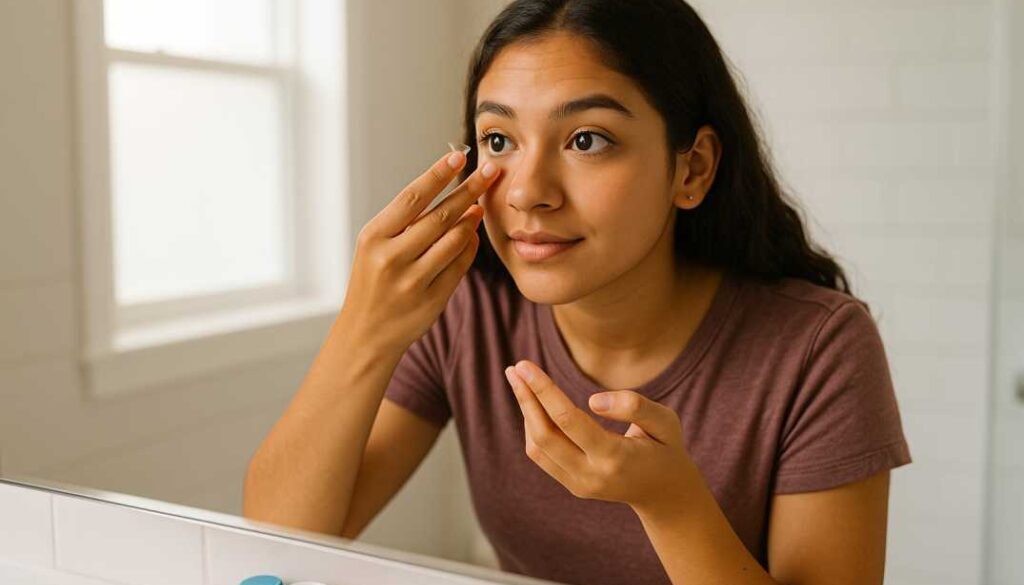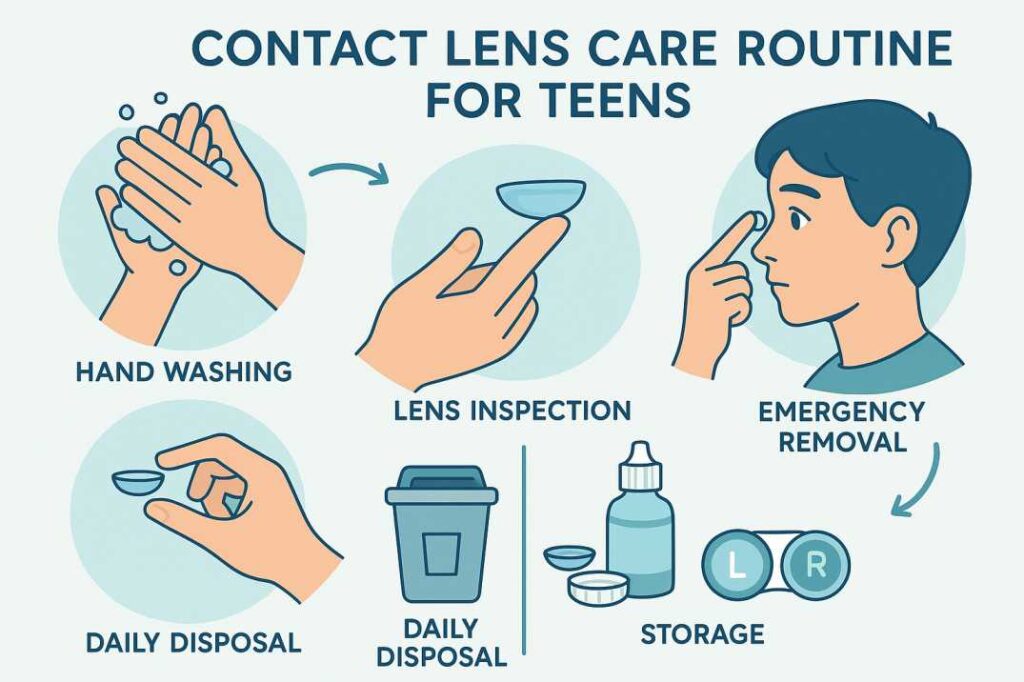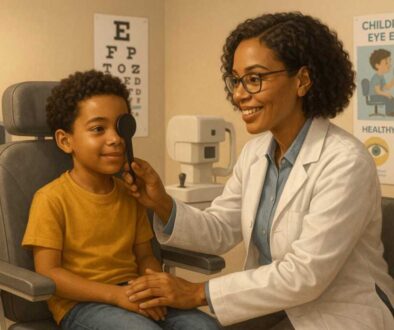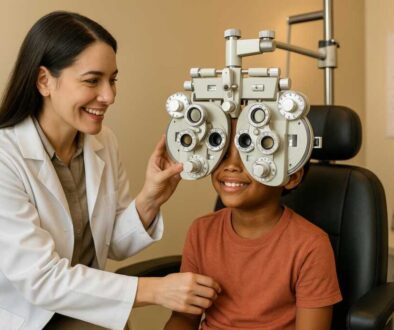Contact Lenses for Teenagers: Complete Safety Guide 2025
Are Contact Lenses Safe for Teenagers?
Are contact lenses safe for teenagers? This question concerns every parent when their adolescent first expresses interest in ditching glasses for contacts. The answer, supported by extensive 2025 research, is reassuring: contact lenses are safe for teenagers when proper care protocols are followed.
Contact lenses for teenagers: Essential 2025 safety facts:
- 14-15% of U.S. teenagers (ages 12-17) currently wear contact lenses safely
- Adolescents demonstrate lower infection rates than many adult wearers
- Daily disposable lenses carry infection rates of only 1 per 5,000 wearers annually
- Six-year longitudinal studies show no serious adverse events in teenage daily lens users
Approximately 3 million American teenagers wear contact lenses, with research consistently demonstrating that adolescents who follow proper care protocols experience fewer complications than their adult counterparts. This counterintuitive finding reflects teenagers’ better compliance with hygiene instructions and increased parental supervision.
Compelling advantages for teenage contact lens wearers:
- Enhanced self-confidence: Adolescents report greater comfort in social situations
- Athletic performance: Unobstructed peripheral vision and freedom from breakage concerns
- Lifestyle flexibility: Compatibility with protective eyewear and fashion choices
- Academic benefits: Improved focus without visual distractions from frames
Success in teenage contact lens wear depends less on chronological age than on individual maturity, responsibility, and commitment to proper hygiene practices. With appropriate guidance from qualified eye care professionals, contact lenses can transform your teenager’s visual experience while maintaining optimal eye health.
Determining Readiness: When Teenagers Can Safely Start
Contact lens candidacy transcends age requirements, focusing instead on individual maturity and responsibility markers. While most eye care professionals consider ages 12-14 optimal for initiation, younger adolescents may succeed with proper support systems.
Critical Maturity Assessment Criteria
Responsibility indicators for teenage contact lens success:
- Consistent completion of daily tasks without repeated reminders
- Maintenance of personal hygiene standards
- Adherence to medication schedules when applicable
- Careful handling of personal belongings
- Honest communication about problems when they arise
Safety awareness requirements:
- Understanding the importance of hygiene before eye contact
- Willingness to report discomfort immediately
- Commitment to professional follow-up appointments
- Recognition that shortcuts compromise eye health
Collaborative Decision-Making Process
Successful contact lens initiation requires alignment between three key stakeholders: the adolescent, parents, and eye care professional. This collaborative approach ensures a comprehensive evaluation of readiness factors beyond simple age considerations.
Warning signs suggesting delayed initiation:
- Frequent misplacement of personal items
- Inconsistent adherence to healthcare routines
- Resistance to safety instructions
- Unrealistic expectations about lens wear convenience
Positive readiness indicators:
- Self-motivated interest in contact lens wear
- Demonstrated responsibility in other life areas
- Realistic understanding of daily care requirements
- Commitment to professional supervision
Best Contact Lens Types for Teenagers in 2025
Contemporary contact lens technology offers multiple options specifically advantageous for adolescent wearers. Understanding the characteristics of each type enables optimal selection based on individual needs, lifestyle factors, and maturity levels.
Daily Disposable Lenses: The Preferred Choice for Teenagers
Daily disposable lenses represent the optimal choice for most teenage contact lens wearers, eliminating care requirements while maximizing safety and convenience.
Advantages for adolescent users:
- Zero maintenance protocols: No cleaning solutions or storage systems required
- Optimal infection prevention: Fresh, sterile lens surface daily
- Lifestyle compatibility: Perfect for unpredictable teenage schedules
- Error forgiveness: Lost or damaged lenses are easily replaced
- Cost transparency: Predictable daily expense structure
Best daily disposable options for teenagers in 2025:
- Silicone hydrogel dailies: Superior oxygen permeability for extended wear comfort
- Standard hydrogel dailies: Cost-effective solution for occasional use
- Myopia control dailies: Dual-purpose vision correction and progression control
Extended Wear Options for Committed Users
Monthly or bi-weekly disposable contact lenses suit teenagers demonstrating exceptional responsibility with personal care routines and daily lens wear commitment.
When to consider monthly contact lenses for teenagers:
- Demonstrated excellence in personal hygiene maintenance
- Daily contact lens wear is planned for vision correction
- Family budget considerations favor longer replacement cycles
- Absence of allergies or ocular sensitivities
Success requirements for teenage monthly lens wearers:
- Strict adherence to cleaning and disinfection protocols
- Regular storage case replacement (monthly)
- Never sleeping in lenses unless specifically designed for overnight wear
- Immediate discontinuation upon experiencing any discomfort
Specialty Lenses for Specific Vision Needs
Toric contact lenses for teenage astigmatism: Specialized lens designs correcting astigmatism are available in both daily and extended wear options, requiring precise fitting but offering excellent vision correction.
Myopia control contact lenses for teenagers: Growing research demonstrates that specialized contact lenses can slow myopia progression in adolescents. The FDA has approved specific lenses for myopia control in children aged 8-12, with continued benefits through teenage years.
Orthokeratology (Ortho-K) for teenagers: Rigid contact lenses worn overnight temporarily reshape the cornea, providing clear daytime vision without lens wear. Popular for myopia control and teenage athletes.
Contact Lens Options to Avoid for Teenagers
Extended wear overnight lenses: Eye care professionals generally recommend against overnight lens wear for teenagers due to increased infection risk and compliance challenges.
Non-prescription colored lenses: Cosmetic contact lenses without prescription represent significant safety risks and should only be obtained through licensed eye care professionals with proper fitting and instruction.
Essential Safety Guidelines Every Teen Must Follow
Successful contact lens wear requires unwavering adherence to established safety protocols. These evidence-based guidelines form the foundation of healthy, long-term contact lens use for adolescents.
Non-Negotiable Safety Protocols for Teenage Contact Lens Wearers
Hand hygiene standards: Thorough handwashing with soap and water before any lens contact represents the single most critical infection prevention measure. This protocol requires:
- Antibacterial soap and warm water (minimum 20-second duration)
- Complete drying with lint-free towels
- Avoidance of scented or oil-based products that may transfer to lenses
Water exposure prohibitions: Contact lenses must never be exposed to non-sterile water sources, including:
- Swimming pools, hot tubs, and natural water bodies
- Shower water and tap water for cleaning or storage
- Saliva or other bodily fluids for lens moistening
Replacement schedule adherence: Lens replacement schedules are determined by material degradation rates and safety profiles:
- Daily disposables: Single-use only, immediate disposal after removal
- Weekly lenses: Replacement every seven days regardless of actual wear time
- Monthly lenses: Replacement every 30 days from package opening
Emergency Response Protocols for Teenagers
Immediate discontinuation criteria: Contact lens wear must cease immediately upon experiencing:
- Acute eye pain or severe discomfort
- Sudden vision changes or loss
- Intense redness or inflammatory response
- Purulent discharge or unusual tearing
- Photophobia or light sensitivity
Professional consultation requirements: Prompt eye care professional evaluation is essential for:
- Persistent discomfort following lens removal
- Any symptoms suggestive of infection
- Trauma or injury during lens wear
- Unexpected vision changes
Daily Care Routines and Hygiene Practices
Establishing systematic care routines ensures optimal safety and lens performance for teenage users. These protocols must become automatic behaviors requiring minimal conscious effort.
Morning Preparation Protocol for Teenage Contact Lens Wearers
Pre-insertion assessment:
- Evaluate eye comfort and appearance for any abnormalities
- Ensure adequate lighting and clean workspace preparation
- Verify hand cleanliness and absence of residual cosmetic products
Lens inspection procedures:
- Examine each lens for tears, deposits, or irregular edges
- Confirm proper orientation (inside-out detection)
- Verify lens identity (particularly important for different prescriptions)
Evening Care Procedures
For teenage daily disposable users:
- Remove lenses using the proper pinch technique
- Dispose of immediately without cleaning attempts
- Apply lubricating drops if experiencing dryness
- Maintain backup spectacles in accessible locations
For teenage extended wear lens users:
- Clean lenses immediately upon removal using approved solutions
- Store in a fresh disinfecting solution nightly
- Replace storage cases monthly
- Allow cases to air-dry completely between uses
Hygiene Best Practices for Teenagers
Advanced hand washing protocol:
- Use unscented, non-oily soap exclusively
- Scrub for a minimum of 20 seconds, focusing on fingertips
- Rinse thoroughly with clean water
- Dry completely with lint-free towels
- Avoid hand creams or lotions before lens handling
Environmental considerations for teenage contact lens wearers:
- Apply cosmetics after inserting contact lenses
- Remove contact lenses before makeup removal
- Avoid dusty or smoky environments when possible
- Maintain clean bathroom and lens storage areas
Troubleshooting Common Problems
Understanding typical challenges and their appropriate responses enables proactive problem management and prevents minor issues from becoming serious complications.
Normal Adaptation Phenomena in Teenage Contact Lens Wearers
Expected initial experiences:
- Mild lens awareness (typically resolving within 72 hours)
- Slight increase in tear production during accommodation
- Minor vision fluctuation with blinking
- Heightened blink frequency initially
Concerning symptoms requiring immediate attention:
- Pain exceeding mild discomfort levels
- Vision degradation is not improving with blinking
- Persistent foreign body sensation
- Inflammatory signs (redness, swelling, discharge)
Professional Evaluation Requirements
Routine follow-up schedule for teenage contact lens wearers: Eye care professionals recommend monitoring contact lens wearers under age 18 every six months to ensure continued safety and optimal lens performance.
Emergency consultation criteria:
- Persistent symptoms following lens removal
- Signs of infection or inflammatory response
- Unexpected vision changes or loss
- Trauma during lens wear
When to Discontinue Contact Lens Wear
Sometimes, despite comprehensive education and support, contact lens wear may not be appropriate for certain teenagers at specific times. Discontinuation indicators include:
- Recurrent infections despite proper care
- Inability to maintain basic safety protocols
- Psychological stress related to lens management
- Persistent eye health issues exacerbated by lens wear
Sports, Activities, and Lifestyle Integration
Contact lenses offer significant advantages for active teenagers, but proper integration with sports and recreational activities requires specific considerations and safety protocols.
Contact Lens Advantages for Teenage Athletes
Performance benefits:
- Complete peripheral vision without frame obstruction
- Elimination of fogging and weather-related visual interference
- Compatibility with protective sports eyewear
- Reduced injury risk compared to eyeglasses during contact sports
Sport-specific considerations for teenage contact lens wearers:
Contact sports (football, basketball, soccer):
- Daily disposable lenses are recommended for easy replacement
- Mandatory protective eyewear over contact lenses
- Backup lenses and glasses are maintained on the sidelines
- Immediate removal following any ocular trauma
Water sports safety: Contact lens wear is contraindicated during water activities due to infection risks.
- Swimming pools contain chlorine and potential pathogens
- Ocean water harbors salt and microorganisms
- Lakes and rivers present parasite and bacterial exposure
- Prescription swim goggles provide safer alternatives
Digital Device Management for Teenage Contact Lens Wearers
Modern teenagers’ extensive screen time requires specific contact lens management strategies:
- 20-20-20 rule implementation: Every 20 minutes, focus on objects 20 feet away for 20 seconds
- Frequent rewetting drops are used during extended computer sessions
- Proper room lighting to minimize digital eye strain
- Blue light filtering consideration, as recommended by eye care professionals
Seasonal Considerations for 2025
Fall and winter challenges:
- Dry indoor heating systems reduce humidity and increase lens discomfort
- Temperature changes potentially affecting lens positioning
- Holiday activities requiring special planning around late nights and makeup use
Spring and summer considerations:
- Increased allergen exposure requires additional lens care attention
- Greater UV exposure necessitates protective eyewear over contact lenses
- Travel planning requires adequate supply management
- Swimming season temptations require constant vigilance
A Parent’s Guide to Supporting Success
Parental support significantly influences teenage contact lens success rates. Understanding your role and implementing appropriate oversight ensures optimal outcomes while fostering independence.
Initial Assessment and Decision Support
Comprehensive readiness evaluation:
- Observe daily responsibility patterns over several weeks
- Assess motivation sources (intrinsic interest versus peer pressure)
- Evaluate communication patterns and honesty levels
- Consider current healthcare compliance behaviors
Professional consultation preparation:
- Attend fitting appointments with your teenager
- Document care instructions and emergency protocols
- Establish clear expectations and consequences
- Schedule appropriate follow-up appointments
Creating Supportive Home Environments
Physical environment optimization:
- Designate clean, well-lit contact lens care areas
- Stock appropriate supplies (solutions, cases, backup glasses)
- Maintain rewetting drops in multiple accessible locations
- Ensure clean towels and hygienic storage options
Routine establishment support:
- Help develop consistent morning and evening protocols
- Set smartphone reminders for removal times and case replacement
- Plan lens supply management and reordering systems
- Prepare for travel and special event considerations
Monitoring and Oversight Strategies
Daily observation protocols:
- Watch for signs of eye irritation, excessive rubbing, or discomfort complaints
- Monitor compliance with care routines without being intrusive
- Assess overall satisfaction and confidence levels
- Note any academic or activity performance changes
Communication strategies:
- Establish regular check-ins about lens comfort and challenges
- Create an open dialogue about peer pressure and safety temptations
- Provide positive reinforcement for responsible behaviors
- Address concerns promptly and supportively
Intervention Guidelines
When to increase oversight:
- Any signs of infection or eye health problems
- Declining compliance with established protocols
- Academic or social problems potentially related to vision issues
- Peer pressure situations affecting safety behaviors
When to encourage independence:
- Consistent demonstration of responsible care habits
- Appropriate problem-solving and help-seeking behaviors
- Mature handling of minor challenges and setbacks
- Growing confidence and satisfaction with lens wear
Cost Analysis and Insurance Considerations for 2025
Understanding the comprehensive financial implications of teenage contact lens wear enables informed decision-making and appropriate budgeting for families considering this vision correction option.
Initial Investment Costs for Teenage Contact Lens Wear
Professional services (2025 pricing):
- Contact lens fitting exam: $19-$250 (varies by complexity, separate from routine eye exam)
- Comprehensive eye exam: $100-$175 (may be covered by vision insurance)
- Follow-up appointments: $50-$100 per visit
- Teaching/training sessions: Usually included in the fitting fee
- Emergency visits: $75-$150, depending on complexity
First-time supply costs:
- Daily disposable lenses: $50-$75 per month supply (standard prescriptions)
- Monthly lenses: $25-$50 per 6-month supply
- Cleaning solutions: $10-$25 monthly for reusable lenses
- Storage cases: $5-$10, replace every 1-3 months
- Rewetting drops: $8-$15 per bottle
Ongoing Monthly Expenses for 2025
Daily disposable lens users:
- Standard daily lenses: $50-$75 per month (both eyes)
- Premium daily lenses: $60-$90 per month
- Specialty dailies (toric, multifocal): $70-$120 per month
- Myopia control dailies: $80-$120 per month
Monthly lens users:
- Contact lenses: $15-$25 per month
- Cleaning solution: $10-$15 per month
- Storage case replacement: $2-$5 per month
- Rewetting drops: $5-$10 per month
- Total monthly cost: $32-$55 per month
Insurance Coverage Realities for 2025
Vision insurance benefits: Many vision insurance plans provide:
- Annual plans: $150-$180 per year, with typical benefits:
- $120-$150 toward contact lenses or eyeglasses
- Full or partial coverage for standard comprehensive eye exams
- Contact lens fitting fee coverage: 15% off with copays typically $25-$60
- Prescription lens coverage for glasses
- Major insurers accepted: Most practices work with United Healthcare, Blue Cross Blue Shield, VSP, and EyeMed.
Medical insurance considerations:
- Therapeutic lenses: May be covered under medical insurance for certain conditions
- Eye infections or injuries: Typically covered as medical expenses
- Routine care: Usually requires separate vision insurance
Cost-Saving Strategies for 2025
Smart purchasing approaches:
- Online retailers: Often 20-40% less than in-office purchases
- Bulk purchasing: Annual supplies are frequently discounted
- Manufacturer rebates: Can save $50-$150 annually
- Subscription services: Automatic delivery with promotional pricing
Budget-friendly options:
- Start with daily disposables for occasional wear
- Compare generic versus brand-name alternatives
- Investigate student discounts at eye care practices
- Evaluate different replacement schedule economics
Comparing Costs: Contacts vs. Glasses for 2025
Annual cost comparison (2025):
- Quality glasses: $200-$600 (lasting 2-3 years)
- Contact lenses: $600-$1,200 annually, including all supplies for daily disposables
- Monthly contact lenses: $200-$400 annually, including cleaning supplies
- Combination approach: Many families find glasses + occasional contact lens wear most economical
Hidden costs to consider:
- Replacement contacts: For lost or torn lenses ($15-$30 per replacement)
- Backup glasses: Still necessary for contact lens wearers ($150-$400)
- Travel supplies: Extra costs for vacations and trips
- Emergency care: Potential costs for complications ($75-$200)
Safety First: Evidence-Based Research on Teenage Contact Lens Safety
Contemporary research provides compelling evidence supporting contact lens safety in adolescent populations. Understanding both the documented risks and proven benefits enables informed decision-making for families considering this vision correction option.
Evidence-Based Safety Profile for 2025
Current safety statistics for teenage contact lens wearers:
- Daily disposable lenses: 1 infection per 5,000 wearers annually
- Monthly replacement lenses: 1 infection per 1,000 wearers annually
- Serious complications (microbial keratitis): 0.1% across all age groups
- Emergency department visits: 13,500 annual cases among all pediatric contact lens users
These statistics demonstrate remarkably low complication rates, particularly when compared to other routine adolescent activities and medical interventions.
Contemporary Research Findings (2021-2025)
Recent longitudinal studies provide robust evidence supporting adolescent contact lens safety:
Woods et al. Six-Year Longitudinal Study (2021) Research published in Ophthalmic and Physiological Optics tracked 144 children wearing daily disposable lenses, documenting only three discontinuations due to ocular adverse events over the entire study period, with zero serious complications.
Bullimore Comprehensive Safety Review (2017)
Analysis published in Eye & Contact Lens concluded that “corneal infiltrative event incidence in children equals or falls below adult rates, with markedly lower rates in the youngest cohort (8-11 years).”
FDA Safety Guidelines (2025) Official consumer guidance acknowledges that while 13,500 children annually seek emergency care for contact lens complications, serious outcomes remain rare with proper supervision and care protocols.
Risk-Benefit Analysis for Teenage Contact Lens Wear
Documented benefits of teenage contact lens wear:
- Psychological advantages: Enhanced self-perception and social confidence
- Functional improvements: Superior peripheral vision and activity compatibility
- Safety considerations: Reduced injury risk during sports compared to eyeglasses
- Myopia management: Specialized lenses can slow nearsightedness progression
Primary risk factors requiring management:
- Infectious complications: Minimized through proper hygiene and appropriate lens selection
- Mechanical trauma: Prevented by correct insertion/removal techniques
- Allergic reactions: Addressed through material selection and replacement schedules
- Compliance issues: Mitigated through education and parental oversight
Conclusion: Setting Your Teen Up for Contact Lens Success
Contact lenses represent a safe, effective vision correction option for responsible teenagers when proper protocols are followed. Current research consistently demonstrates that teenagers can safely wear contact lenses with complication rates equal to or lower than those of adult wearers, particularly with daily disposable lenses.
Key takeaways for parents in 2025:
- Safety statistics favor teenagers: Recent studies show lower infection rates in young contact lens wearers compared to adults
- Daily disposables offer optimal safety: With infection rates of just 1 per 5,000 wearers annually, daily disposable contact lenses provide the safest option for teenagers
- Maturity matters more than age: Successful teenage contact lens wear depends on responsibility and proper hygiene habits rather than specific age requirements
- Professional guidance is essential: Contact lens fittings and ongoing care from qualified eye care professionals ensure optimal safety and success
Your next steps:
- Assess your teenager’s readiness using the maturity indicators discussed throughout this guide
- Schedule a comprehensive contact lens consultation with a qualified eye care professional
- Choose appropriate lens types based on your teen’s lifestyle, prescription needs, and responsibility level
- Establish clear safety protocols and daily care routines from day one
- Plan for ongoing professional monitoring with regular follow-up appointments
The bottom line: The research is conclusive: responsible teenagers can be successful, safe contact lens wearers. Modern contact lenses for teenagers offer excellent safety profiles, especially daily disposables, and the benefits—improved confidence, athletic performance, and social comfort—often significantly outweigh the minimal risks when proper care is maintained.
Your role as a parent is to provide guidance, support, and oversight while helping your teenager develop the independence and responsibility that successful contact lens wear requires. With proper education, appropriate lens selection, and professional oversight, contact lenses can provide your teenager with clear vision, increased confidence, and the freedom to participate fully in all their activities.
Take action today: Contact a qualified eye care professional to discuss whether contact lenses are right for your teenager. Every teen’s needs are unique, and a personalized professional assessment is the foundation of safe, successful contact lens wear.
Medical Disclaimer: This article is for educational purposes only and does not substitute for professional medical advice. Always consult with a qualified eye care professional before making decisions about contact lens wear for your teenager.
FAQs
-
-
Most teens can start between ages 12 and 14, when they show responsibility with lens care and hygiene.
-





